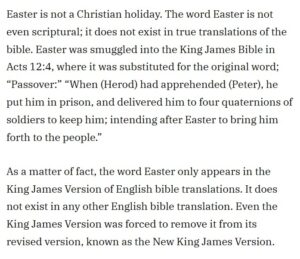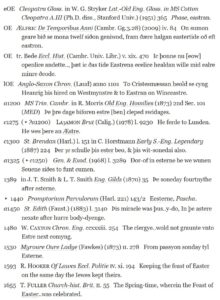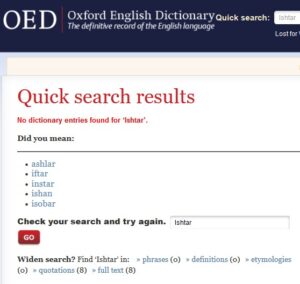Date of this post: June 26, 2025.
Topics:
- Background. (Plus, issues with the Feb 2025 edition and complimentary offer).
- The differences between the 2018 and 2025 editions of The October Testament.
- Why we will continue to publish The October Testament after the full New Matthew Bible is produced (hopefully in 2026).
Background
The October Testament was first published in 2016. Since then, it has been revised a few times, including in 2018, 2022, and then in February and June 2025. (See below re the edition of February 2025, which contained design flaws.) I hope that the June 2025 edition of the October Testament will be the final revision.
There are two print formats of The October Testament:
1. The regular format, which measures 7 x 8.25″ with a font size of just over 9 points. It comes in two editions:
– The 2018 leather edition, available through our website bookstore. This is a high quality custom printing, with a ribbon marker. I stock the books and ship them from my home in Canada.
– The 2025 paperback. Available only on Amazon. It is print-on-demand through KDP (Amazon’s publishing arm). I have kept the price at $US16.50, but with rising costs I may soon need to increase it, or I will be in negative royalty territory (meaning that I pay Amazon for each book they print).
2. The full-size format, which measures 8 x 10″ with a font size of 11.25 points. The June 2025 edition, is now available through Amazon and online bookstores, or you can order it through your local bookstore. There are two editions:
– 2025 Full-size paperback
– 2025 Full-size case laminate hardcover.

Hardcover (case laminate) edition of The October Testament. Available through bookstores online or at your local shop.
TIP: The full-size paperback is sold directly by Amazon and through bookstores, BUT the hardcover case laminate is available only through bookstores (as listed on Amazon or through a local shop). This is because when we first published the hardcover, Amazon did not make hardcover books. In any case, a difference between the bookstore printer (Lightning Source) and Amazon’s printing arm (KDP) is that Lightning Source uses 50 lb paper as opposed to the 60 lb paper that KDP (usually) uses. If you would prefer lighter-weight paper, order the full-size edition, whether paperback or hardcover, from a bookstore.
Notes:
– PDF and Kindle formats are also available. Go to our website bookstore for links to all formats and editions.
– Online platforms: The October Testament is available on Biblegateway.com, Olive Tree Bible Software, and Logos Bible Software. Currently these online platforms all show the 2022 edition. They have the updated 2025 Scriptures, but I do not know how long it will take them to do the updates.
Complimentary offer.
As mentioned, there were some design flaws in the February 2025 edition of The October Testament. If anyone reading this purchased a copy of The October Testament between Feb and mid-June 2025, you can check if yours is a flawed copy by going to page 128. If the note references in the left margin are too low, and do not align with notes a and b, then you have the flawed edition.
I am offering to send a new book, at my own expense, to people who bought a flawed copy. I must limit this offer to a paperback copy of either the regular or full-size formats, and only in those parts of the world where Amazon KDP services your address. To claim a complimentary copy, first sign the copyright page with your name written vertically over top of the ISBN number. Then take a photo of the signed copyright page and send it to ruth@newmatthewbible.org along with your shipping address.
And please be patient! I don’t know how many people will see or respond to this, but dealing with it will take me some time on top of my already full plate of tasks!
The differences between the 2018 and June 2025 editions of The October Testament
Until we sell out of the 2018 leather edition, people who visit this website will see a pop-up that says the cost of the 2018 leader edition is reduced to clear the way for the new edition. People have sometimes asked what the differences would be between the 2018 and the new edition. I can now answer that question.
There are very few substantive revisions. Most changes relate to formatting and editorial details, besides fixing a few typographical errors. I will give the three main revisions below, and people can skip the rest of the information if they want.
Three main revisions:
1 John 2:2
In accordance with my guiding principle of retaining proverbial verses in their familiar wording, I had originally revised 1 John 2:2 in accordance with the common use, and also to harmonize with the “Comfortable Verses” (as they are called) in the Book of Common Prayer of the Church of England (BCP). But a reader suggested that I should restore Tyndale’s original translation, and I have done so:
1537 Matthew Bible: If any man sin, yet we have an advocate with the Father, Jesus Christ, which is righteous, 2 and he it is that obtaineth grace for our sins: not for our sins only, but also for the sins of all the world.
2018 October Testament: Yet if anyone sins, we have an advocate with the Father: Jesus Christ the Righteous, 2 and he is the propitiation for our sins; and not for our sins only, but also for the sins of all the world.
2025 (Feb edition): Yet if anyone sins, we have an advocate with the Father: Jesus Christ the Righteous, 2 and he it is who obtains grace for our sins; and not for our sins only, but also for the sins of all the world.
I have mixed feelings about this revision, because it departs from the BCP. But on the other hand, it is true to Tyndale.
* * * * * *
1 John 5:1
I also restored Tyndale’s original translation here, so that the verse could be interpreted in accordance with the Church fathers who believed that it referred to Christ. To me, the passage is somewhat confusing as a whole, but I felt it best to restore Tyndale:
1537 Matthew Bible: Whosoever believes that Jesus is Christ, is born of God. And every one that loves him which begat, loves him also which was begotten of him.
2018 October Testament: Whoever believes that Jesus is the Christ, is born of God. And everyone who loves him who begat, loves also the child who was born of him.
2025 (Feb edition): Whoever believes that Jesus is the Christ, is born of God. And everyone who loves him who begat, loves also him who was begotten of him.
* * * * * *
Acts 8:33
I revised Acts 8:33 in accordance with Martin Luther’s understanding of the related Isaiah passage (Isaiah 53:8, a prophecy of Christ). The issue is the word ‘generation.’ This old English word, like the Greek and Hebrew it translated, was ambiguous, with a number of possible applications, and has been variously translated. See the original translation with our 2018 and 2025 renderings:
1537 Matthew Bible (Tyndale’s translation): Because of his humbleness, he was not esteemed: who shall declare his generation? For his life is taken from the earth.
2018 October Testament (following others): Because of his humbleness, he was not esteemed. But who can number his descendants? For his life is taken from the earth.
2025 (June edition, following Luther): Because of his humbleness, he was not esteemed. Who shall declare his years? For his life is taken from the earth.
See below also how Isaiah 53:8 will read in the New Matthew Bible (NMB) Old Testament, and part of the note I added on Isaiah 53 to explain Luther’s understanding:
Isaiah 53:8
1537 Matthew Bible (Myles Coverdale’s translation): He shall be had away, his cause not heard, and without any judgment: whose generation yet no man may number, when he shall be cut off from the ground of the living.
NMB 2025: He will be taken away, his cause not heard, and without any justice; whose years yet no man may number,* when he will be cut off from the ground of the living.
*NMB note on Isaiah 53:8: Luther: This verse must be understood to refer to age or years. Here the prophet established Christ in an eternal age after he was cut off from the ground of the living (ie, after he was killed). That is, Christ was brought into the eternal life, which is not measured in time.
In conclusion, not only do I believe Luther most likely had it right, but now Acts 8:33 will harmonize with Isaiah 53:8 in the complete NMB.
* * * * * *
Updating the verb ‘sanctify’
When I worked with the Five Books of Moses in 2024, I realized that I needed to better understand and express the meanings of the verb ‘sanctify.’ Its limited modern sense, “to purify” or “make clean,” does not properly express the true meaning in all contexts.
In older English, to “sanctify” a thing could mean, depending on the context, to hallow it, to set it apart for some holy purpose, or to consecrate or dedicate it. This accorded with the Greek and Hebrew, The purpose of such setting apart, etc., is in many contexts to make holy for our holy God. As I reviewed The October Testament in 2025, I was struck anew by how the apostles emphasized the important of attaining to holiness in this life in order to prepare us for the next, and to make us meet for God. A few examples only:
1 Corinthians 1:8 He will strengthen you to the end, so that you may be blameless in the day of our Lord Jesus Christ.
Romans 15:16 … so that the Gentiles may be an acceptable offering, sanctified by the Holy Spirit.
Ephesians 1:4 … he had chosen us in him before the foundation of the world was laid, to be holy and without blame before him through love.
Ephesians 5:27 … to make it for himself a glorious congregation, without spot or wrinkle or any such thing, but to be holy and without blame.
I studied all Tyndale’s uses of the verb ‘sanctify’ in the New Testament and prayerfully revised about eight verses to express what I believed was the full sense and intended emphasis. Three examples:
John 10:36
Tyndale 1537: say ye then to him, whom the father hath sanctified, and sent into the world, thou blasphemest, because I said I am the son of God?
2018 October Testament: do you then say to him whom the Father has sanctified and sent into the world, You blaspheme, because I said I am the Son of God?
2025 (Feb) revision: do you then say to him whom the Father has set apart as holy and sent into the world, You blaspheme, because I said I am the Son of God?
The modern sense of “sanctified” (purified, cleansed) was not good in John 10:36, because the Son was already sinless. Other Bible versions have here “sanctified and set apart,” “consecrated,” “set apart,” “set me apart for this holy purpose,” “chose me,” and also “set apart as holy,” as we put.
* * * * * * * *
Matthew 23:17
Tyndale 1537: Whether is greater, the gold, or the temple that sanctifieth the gold?
2018 October Testament: Which is greater: the gold, or the temple that sanctifies the gold?
2025 (June) revision: Which is greater: the gold, or the temple that hallows the gold?
* * * * * * * *
Romans 6:22:
Tyndale 1537: but now are ye delivered from sin, and made the servants of God, and have your fruit that ye should be sanctified, and the end everlasting life.
2018 October Testament: But now you are delivered from sin, and made the servants of God, and have as your fruit to be sanctified, and the end everlasting life.
2025 (June) revision: But now you are delivered from sin, and made the servants of God, and have as your fruit to be sanctified, consecrated in holiness; and the end is everlasting life.
For comparison, other Bible versions have here, “ye have your fruit unto holiness,” “you have the consequence of a holy life,” “you have your fruit resulting in sanctification,” “This results in a holy life,” and “Your gain is a life fully dedicated to him.”
Also, in the June 2025 October Testament, I added parallel scripture references (PSRs) emphasizing the Christian’s call to holiness. For example, at Romans 6:22 we now have, as shown in the picture below:

* * * * * * * * *
Minor revisions
The minor changes I made to the October Testament were:
- To emend punctuation in accordance with my maturing editorial preferences.
- To standardize spelling and formatting, including the format of PSRs, and to tighten up spacing between some of the chapters and “The Notes” sections.
- The most noticeable formatting change was to add what my book designer called a “holding line” at the top of each page, just below the header. Due to the unequal width of the 3 columns used in each page, the centre of the main text is offset from the centre of the page. The “holding line” helps the eye take in the full width of the three columns together, so the header more clearly appears centred on the page. I love this new feature.
- I did a bit more updating of the English in response to reader requests, such as to further reduce the use of ‘whosoever’ (to read ‘whoever’) and to use more modern syntax in a few places. I also updated the obsolete idiom, “cast in the teeth.” I apologize to those who enjoy such older English; such persons may prefer the 2018 edition because it is closer to Tyndale’s expression.
- With reluctance, I updated ‘maiden’ in Matthew 1:23. Not only is it obsolete in the sense ‘virgin,’ this will make it to accord with Coverdale’s translation of the prophecy of the virgin birth in Isaiah 7:14. So Matthew 1:23 now reads in the 2025 edition of the October Testament: “Behold, a virgin will be with child.”
Again, except for the “holding line” and, perhaps, the update at Matthew 1:23, these modest revisions will be unnoticeable to most readers. Certainly, none of them change the meaning, but should make the New Testament more understandable for the ploughboy, and assist pastors and priests who use The October Testament in their congregations.
Will we still publish The October Testament after the full New Matthew Bible is produced (hopefully in 2026)?
Yes, The October Testament will continue to be available after the complete New Matthew Bible (NMB) is published. The October Testament contains many features that will not be included in the full NMB, such as:
– Tyndale’s prologues to the Gospels and epistles. At this point I have not decided if I should include his prologue on Romans in the NMB. He largely translated this from Martin Luther, and it was part of the 1537 and 1549 Matthew Bibles, but it is a very long prologue.
– Notes and pointing glosses taken from Tyndale’s 1534 New Testament, which were not in the 1537 MB.
– My brief history of the Matthew Bible, other introductory material, my supplement on Tyndale’s translation of ecclesia by congregation, and most of my marginal notes on history, linguistics, etc.
– Also, certain of John Rogers’ notes, especially those of purely historical interest, will be omitted, mainly for space reasons.
Therefore, The October Testament will always be a richer and fuller resource for readers of the New Testament and for fans of William Tyndale and the Matthew Bible, so we will continue to publish it. However, at this point I am re-thinking if a new leather edition is warranted. It will be expensive, and I must stock the books at home and ship them myself, and I’m not getting any younger. That decision will have to wait. But in any case, it will always be available print-on-demand though Amazon and through bookstores.
* * * * *
Surely the Heavenly Adam’s seed
Shall in our earthly hearts take root,
Spring up in works, its branches spread,
And holiness its golden fruit.
(From a Wesley hymn)






